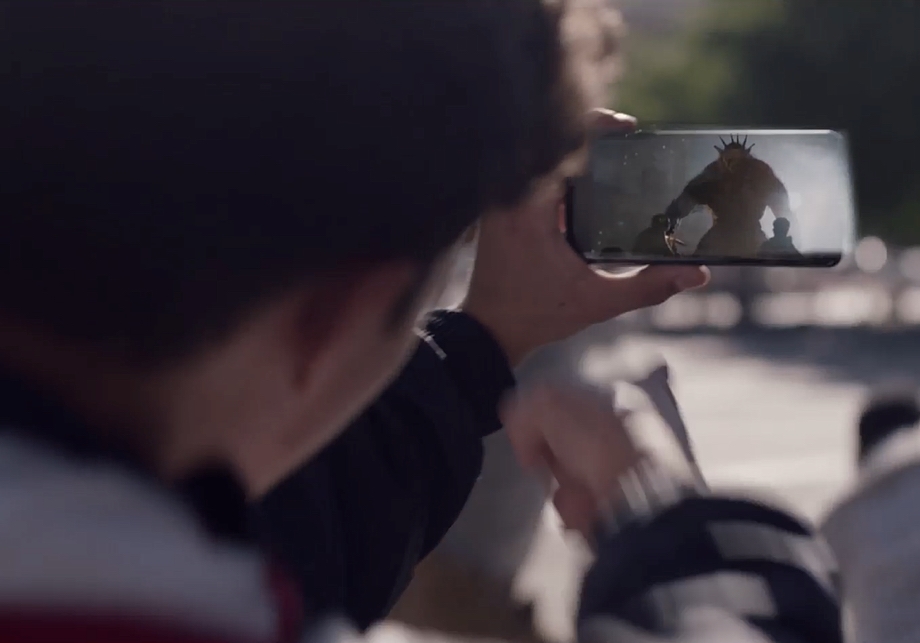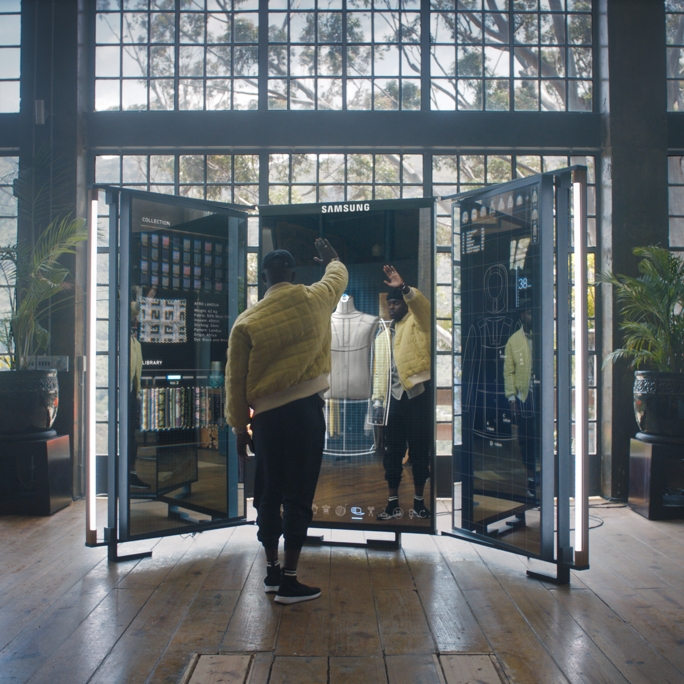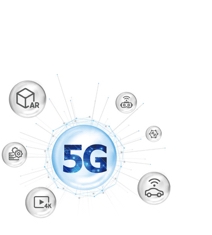5G is coming, and it's going to drive 2019's technology trends in a big way.
Find out how it’s going to change your life.
Find out how it’s going to change your life.

5G is poised to change the game in 2019 and beyond, but how exactly will it do that? How is it going to impact your life, and what is it going to change? New technology comes with new questions, so we're breaking down what 5G is, what 5G isn't, and how it's going to impact the technology trends of 2019.

What 5G is—and what it isn't
5G simply means “fifth generation,” as in the fifth generation of cellular technology. 3G was the third generation, 4G was the fourth, and 5G is the fifth. Only 5G-capable phones will be able to support this new technology.
Service providers' infrastructures and networks will require significant upgrades to support this fifth generation of cellular technology. With so much technological investment, the coming age of 5G promises to deliver unparalleled speed and connections, and people are incredibly excited for what it will bring.
The hype for 5G is real—so real, in fact, that some 4G LTE networks are adding enhancements to their 4G services in anticipation of the coming evolution. And while those enhancements will definitely improve speed and connections, providing up to 3x faster peak download speeds, only 5G-specific networks with 5G devices will be able to deliver theoretical download speeds of up to 20 Gbps – 20x faster than current 4G LTE networks.
It’s easy to underestimate just how much faster 5G will be. The most noticeable difference will be its significantly reduced latency, or how quickly signals are sent to and from your device. For context, 3G’s latency response rate was 100 milliseconds, 4G’s was 50 milliseconds, and 5G will be 1 millisecond. This will transform the future of gaming, wellness, working and things we can't even think of yet.
Service providers' infrastructures and networks will require significant upgrades to support this fifth generation of cellular technology. With so much technological investment, the coming age of 5G promises to deliver unparalleled speed and connections, and people are incredibly excited for what it will bring.
The hype for 5G is real—so real, in fact, that some 4G LTE networks are adding enhancements to their 4G services in anticipation of the coming evolution. And while those enhancements will definitely improve speed and connections, providing up to 3x faster peak download speeds, only 5G-specific networks with 5G devices will be able to deliver theoretical download speeds of up to 20 Gbps – 20x faster than current 4G LTE networks.
It’s easy to underestimate just how much faster 5G will be. The most noticeable difference will be its significantly reduced latency, or how quickly signals are sent to and from your device. For context, 3G’s latency response rate was 100 milliseconds, 4G’s was 50 milliseconds, and 5G will be 1 millisecond. This will transform the future of gaming, wellness, working and things we can't even think of yet.
The coming age of 5G promises to deliver unparalleled speed and connections.

Mobile gaming levels up with AR
Remember Pokémon GO, the game that took the summer of 2016 by storm? As players moved through the real world, Pokémon would pop up in a map on their phone screens for them to catch. It made us feel like there was an entire world all around us that we could access through our phones.
That was our first taste of Augmented Reality (AR), virtual reality’s less cumbersome cousin, and it’s only going to get better in 2019 as 5G begins to roll out. You won't just be hunting down monsters on your way to the grocery store—you and 50 local players will descend on a park to rid it of a 50-foot frost troll that you can only see through your phones.
That was our first taste of Augmented Reality (AR), virtual reality’s less cumbersome cousin, and it’s only going to get better in 2019 as 5G begins to roll out. You won't just be hunting down monsters on your way to the grocery store—you and 50 local players will descend on a park to rid it of a 50-foot frost troll that you can only see through your phones.

Creativity gets unleashed
5G isn't just going to change how we game—it's going to lead a creative revolution in the worlds of fashion, art, design and more. Much of the creative process already happens within a virtual space like a tablet or laptop, but dynamic displays powered by 5G are going to blur the line between those virtual spaces and the real world.
Until now, digital creation tools have done their best to approximate your ideas on a screen. But with innovations in standing displays, AR mirrors, foldable screens and more, those virtual creative spaces will be able to mimic the mental space where ideas are born. On top of that, 5G's negligible latency will enable those screens to respond in real time, so you can manipulate your creations and ideas with your own hands right on the screen itself.
Until now, digital creation tools have done their best to approximate your ideas on a screen. But with innovations in standing displays, AR mirrors, foldable screens and more, those virtual creative spaces will be able to mimic the mental space where ideas are born. On top of that, 5G's negligible latency will enable those screens to respond in real time, so you can manipulate your creations and ideas with your own hands right on the screen itself.

Better tech, better health
While 2019 might be 5G's year, wearables are also undergoing a major growth spurt at the same time. And when these two technology trends get together, we're going to see some amazing things happen in our health and fitness routines.
With advances in smart fabrics and sensors, wearables are going beyond smartwatches in 2019. We’re going to see wearable technology in shoes, shirts, and more—basically anything that can be worn is going to get some tech sewn into it. And along with lower latency rates, 5G's massive connectivity upgrade is also going to significantly increase how many devices can collaborate together at once. So you won't just know how many steps you took today, you'll know what the weather was during each step, how local humidity affected your stride distance, and how much weight you put on each foot as you stepped.
What's more, your doctor will have access to all of that information and more the minute it's available, meaning they'll already have a pretty clear picture of your health since your last check up before you even walk in the door. So not only will your doctor be able to be a better doctor, you'll save time in the waiting room, too.
With advances in smart fabrics and sensors, wearables are going beyond smartwatches in 2019. We’re going to see wearable technology in shoes, shirts, and more—basically anything that can be worn is going to get some tech sewn into it. And along with lower latency rates, 5G's massive connectivity upgrade is also going to significantly increase how many devices can collaborate together at once. So you won't just know how many steps you took today, you'll know what the weather was during each step, how local humidity affected your stride distance, and how much weight you put on each foot as you stepped.
What's more, your doctor will have access to all of that information and more the minute it's available, meaning they'll already have a pretty clear picture of your health since your last check up before you even walk in the door. So not only will your doctor be able to be a better doctor, you'll save time in the waiting room, too.

Music that moves with you
Entertainment especially has only just begun to scratch the surface of what's capable with 5G. Music is already easily transferred from one speaker to another within a household—but you have to tell it to do that yourself. What if it just did it for you? With 5G empowering devices and sensors in your home, your music will be able to follow you as you move from room to room.
But surely you'd still have to tell your speakers what to play, right? Not with wearable tech tracking your health levels all day. If you come home tense from a long day at work, a comprehensive AI assistant like Bixby will know you're wound up and need to listen to something soothing. Or maybe you just got some great news and need an arena rock setlist to celebrate.
5G will take this emotional adaptability outside of the home, too. As you start running, Bixby will know to play music that gets you fired up and ready to move, and as your run comes to an end, it'll even know to play something to cool you down.
But surely you'd still have to tell your speakers what to play, right? Not with wearable tech tracking your health levels all day. If you come home tense from a long day at work, a comprehensive AI assistant like Bixby will know you're wound up and need to listen to something soothing. Or maybe you just got some great news and need an arena rock setlist to celebrate.
5G will take this emotional adaptability outside of the home, too. As you start running, Bixby will know to play music that gets you fired up and ready to move, and as your run comes to an end, it'll even know to play something to cool you down.





No comments:
Post a Comment